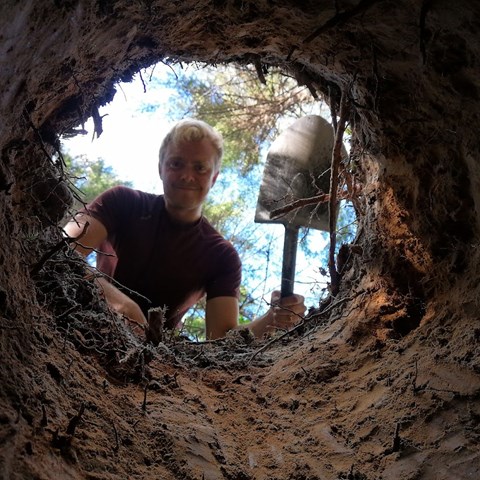Contact
Department of Forest Ecology and Management, Department of Forest Ecology and Management, joint staff

The water guides the way for the forest's growth and its carbon sequestration potential. PhD-student Johannes Larson has mapped this in his dissertation using advanced soil moisture maps – and a shovel.
The forest doesn't grow uniformly. On the contrary, there is a significant variation, largely controlled by the path of water through the landscape, which also affects nutrient availability. With the help of detailed elevation models, it is possible to map this crucial soil moisture, as the topography of the landscape plays a significant role.
Adding new depths to this knowledge is the aim of doctoral student Johannes Larson at the Department of Forest Ecology and Management at SLU in his newly published thesis.
– We know that we can estimate soil moisture very well using these tools. That led us to ask if there is anything else we can estimate with this? Can it explain the variation in nutrient supply, carbon storage, and tree growth?
The Krycklan catchment area in Västerbotten is one of SLU's and Swedish researchers most studied forest landscapes. The entire area, nearly 7000 hectares, is covered in Johannes Larson's study. To conduct a comprehensive study of both the forest and soil content, a large number of samples had to be collected across the entire Krycklan area.
"I used a grid of sample spots, with a distance of 350 meters from each other across the entire Krycklan area. Each sample area had a radius of ten meters, and within these areas, I measured all the trees and dug a 65-centimeter deep pit," says Johannes Larson.
Unavailable spots such as in the middle of a lake, had to be excluded. But there was still a lot of forest land to cover.
– In total, there were 443 pits. From these I took samples at three different depths in the mineral soil and in the organic layer on top. The trees on the areas were measured twice over a five-year period, allowing us to examine differences in tree growth. During the last inventory, we measured over 20,000 trees, Johannes Larson explains.
The hundreds of locations, from dry rocky hills to wet marshes, have been analyzed based on their carbon and nitrogen content. The results show how nutrient availability, which drives tree growth, increases as soil moisture rises down the slopes of the landscape, as soil moisture rises.
– Nitrogen is the most limiting factor for growth in these forests. There are, of course, more factors than soil moisture that affect nitrogen availability, and thanks to the material I have collected, we can provide a unique insight into the large variation within a delimited landscape like Krycklan, says Johannes Larson.
When researchers calculated the total carbon stock in the soil and trees, the importance of the properties in wetlands became clear. Despite a significant amount of carbon being stored in the biomass of trees in areas that are neither too dry nor too wet, the total carbon stock in the wet areas is three times higher than in the dry ones.
Something that Johannes found particularly exciting was investigating how soil moisture related to the variation in tree growth on a landscape scale. By comparing the relative height difference of the trees, researchers could estimate potential growth.
– With the help of remote sensing, we could make this estimation on a landscape scale and then compare it with soil moisture. The results showed a large variation, but with a clear decrease in growth in the wettest areas, says Johannes Larson.
Detailed information is crucial for sustainable forest resource management. To make informed decisions, an understanding of the driving factors behind variation on a landscape scale is needed. Good data allows for refining model accuracy, both for more efficient forest management and to predict the future.
– We have a fairly good understanding of how trees grow, but this type of detailed data on the factors that drive variation within a landscape scale is lacking. It is important, both for how we manage our forests and how they will be affected by climate change, says Johannes Larson.
Johannes Larson will defend his dissertation at the Swedish University of Agricultural Sciences in Umeå at 09:00 on December 8. More information and a link to the entire dissertation can be found here.